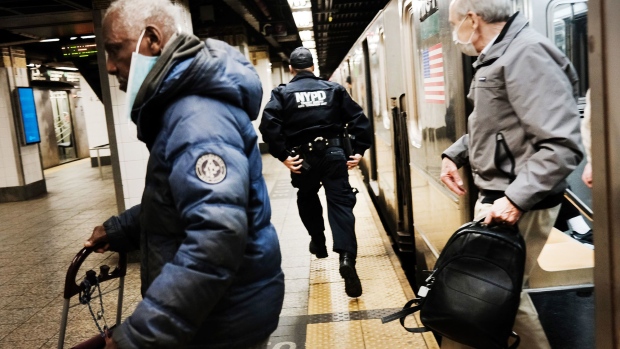May 10, 2022
NYC Boosts Subway Police Patrols as Assaults Spike
, Bloomberg News

(Bloomberg) -- New York City subway riders will see more uniformed police officers on the trains overnight and for longer stretches of time as the NYPD pushes back against a crime spike in the transit system.
In a new strategy, the NYPD is rolling out patrols where cops ride across multiple boroughs, lengthening their presence on trains, Jason Wilcox, the force’s transit chief, said Tuesday during a panel on subway safety conducted by the Manhattan Institute, a conservative think tank. Wilcox said he’s also building an overnight force to police the system at a time when 79% of subway crimes are happening on the trains and on platforms.
“We need to be where the crime is,” Wilcox said. “We need to be where the people can see us. We need to be where the people know we’re there and our very presence makes people feel safer.”
Mayor Eric Adams boosted the number of uniformed officers patrolling the subway after he took office in January and has criticized transit police, including “officers standing at the booth, looking at their phones.” Still, crime continues to plague the system, with 150 reported assaults on the subway in the first three months of 2022, the most for that period since at least 1997, Metropolitan Transportation Authority data show. The agency oversees the city’s subways, buses and commuter rails, the nation’s largest transit network.
Riders were shook after a string of high-profile attacks, including a man opening fire last month in a packed subway car traveling from Brooklyn to Manhattan. A woman was killed in January when she was pushed before an oncoming train at Times Square.
Ridership Rebound
Although ridership has rebounded to levels seen before the subway shooting and December’s omicron-fueled coronavirus wave, it’s still below the 5.5 million weekday average in 2019. Riders took 3.5 million subway trips last Thursday, eclipsing the previous Covid-era peak on Dec. 9 of 3.42 million, according to MTA data.
“This cycle is not going to break itself,” Nicole Gelinas, a senior fellow at the Manhattan Institute, said during the panel in reference to the crime spike. “We can’t just sort of sit back and say, ‘We’ll just wait for 100% of ridership to come back and then fine, we’ll go down.’ That is not likely to happen.”
Police have increased enforcement of quality-of-life infractions like public urination, smoking and fare evasion, which has drawn criticism for targeting vulnerable New Yorkers without necessarily increasing public safety. Transit arrests are up about 1,000 this year from the same period in 2021, Wilcox said.
The issue came to a head this week after Adams defended a decision by NYPD officers to handcuff a woman selling mangoes in the subway without a license. Adams said police were just enforcing the law and that people must “follow rules.”
New York City Comptroller Brad Lander said “handcuffing Maria in front of her daughter for selling fruit does nothing to make our city safer,” in a Twitter post on Monday. “Criminalizing street vendors is a terrible use of resources.”
MTA and police officials have said reducing fare evasion will help deter crime as those who engage in illegal activity are more likely to skip fares. It also saps transit revenue.
Citations for theft of service account for about 79% of transit-related police enforcement, according to Wilcox.
Janno Lieber, MTA’s chief executive officer, formed a panel last month to study how to reduce fare evasion, including design and infrastructure upgrades. Skipped fares on subways, buses and commuter trains, along with drivers evading tolls on MTA bridges, may cost the agency about $500 million this year.
“We just need people to understand there is a consequence to skipping the fare,” John McCarthy, MTA’s chief of external relations, said on the panel. “And it’s a consequence that’s felt, it’s borne, by the entire transit system because of the magnitude of money.”
©2022 Bloomberg L.P.






